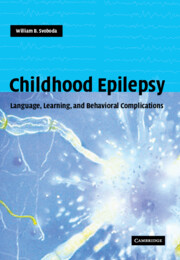Book contents
- Frontmatter
- Contents
- Preface
- Glossary
- 1 Looking ahead
- Part I Speech and language problems
- Part II Learning problems
- Part III Behavior problems
- 27 Mental health needs
- 28 Psychologic development
- 29 Seizure types and modifying factors
- 30 Overview: extrinsic factors
- 31 Behavior problems: general
- 32 Attention deficit disorders
- 33 Anxiety disorders
- 34 Mood disorders
- 35 Disruptive behavior problems
- 36 Psychoses of epilepsy
- 37 Non-epileptic events
- 38 Possible treatment issues
- 39 Helping with psychiatric problems
- 40 Epilog
- Index
- References
36 - Psychoses of epilepsy
from Part III - Behavior problems
Published online by Cambridge University Press: 26 October 2009
- Frontmatter
- Contents
- Preface
- Glossary
- 1 Looking ahead
- Part I Speech and language problems
- Part II Learning problems
- Part III Behavior problems
- 27 Mental health needs
- 28 Psychologic development
- 29 Seizure types and modifying factors
- 30 Overview: extrinsic factors
- 31 Behavior problems: general
- 32 Attention deficit disorders
- 33 Anxiety disorders
- 34 Mood disorders
- 35 Disruptive behavior problems
- 36 Psychoses of epilepsy
- 37 Non-epileptic events
- 38 Possible treatment issues
- 39 Helping with psychiatric problems
- 40 Epilog
- Index
- References
Summary
Psychosis is a condition characterized by delusions, hallucinations, and disorganized speech and behavior (American Psychiatric Association, 1994). Psychoses due to epilepsy differ from non-epileptic psychoses. Psychoses may be ictal, postictal or interictal; the latter may be subdivided into episodic and chronic ongoing. Treatment-related psychoses include postoperative psychosis, anticonvulsantinduced psychosis, and the entities of alternating psychosis and forced normalization.
Psychotic disorders are increased in incidence among patients with epilepsy, especially those with complex partial seizures. A schizophreniform disorder occurs in up to 9.25% of epilepsy patients. Psychosis is a rare phenomenon in children yet significantly increased in epileptic children compared with the normal population. Sporadic cases of psychoses have been reported in children with complex partial seizures, manifest by prominent automatisms, especially when from the left temporal lobe, perhaps of medial-temporal origin. Often, these psychoses are associated with a cerebral abnormality or mental retardation (Dunn, 1998; Lindsay et al., 1979b; Weisbrot & Ettinger, 1998).
Thought disorders
Children with complex partial seizures exhibit an excess of illogical thought patterns, even to the point of psychotic proportions, as compared with children with primarily generalized epilepsy. In both groups, the existence of such problems exceeds that in the non-epileptic population. Children with complex partial epilepsy are prone to display more illogical thought patterns, hallucinations, and delusions compared with children with primary generalized seizures. Complex partial epilepsy patients lack the loose associations or negative signs, such as apathy and flat affect, that are typical for schizophrenia.
- Type
- Chapter
- Information
- Childhood EpilepsyLanguage, Learning and Behavioural Complications, pp. 547 - 565Publisher: Cambridge University PressPrint publication year: 2004



